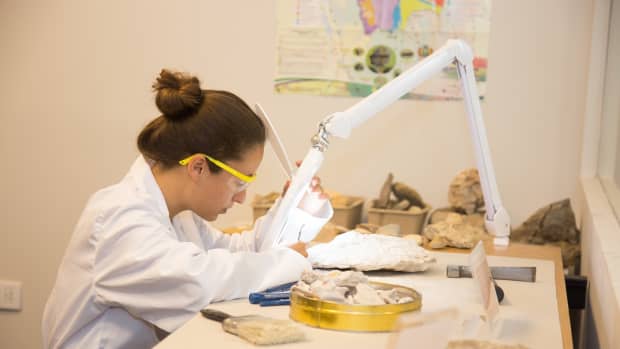Top 8 Freaky Facts About Fungus
8. The Danger of Sock Spores
A case from China illustrated why nobody should sniff their socks. A man, only identified as Peng, had a strange habit. Every day after coming home from work, he would remove his shoes and smell his socks. In 2018, it landed him in hospital.
The 37-year-old suffered from alarming chest pains, a tightness while breathing, and coughing. Doctors diagnosed Peng with pneumonia but realized their mistake when the normal treatment for pneumonia had zero effect on his symptoms. Another examination included X-rays. The imaging did not capture a rose garden. Instead, they showed that Peng's lungs had a serious fungal infection.
The condition was both unusual and hazardous, so doctors questioned the patient about his daily routine. Peng confessed that he was addicted to smelling dirty socks. Apparently, he became ill after inhaling fungal spores sitting in between the socks' fibres.
7. Unique Case of Cave Disease
In 2017, a 70-year-old man went to an Arizona hospital. He was confused but otherwise normal. Scans revealed lesions on his brain and adrenal glands. Fearing the worst, doctors took biopsies to confirm their suspicion of cancer. The tests were negative.
However, he had histoplasmosis (or cave disease). This deadly condition is triggered when spores of the fungus Histoplasma capsulatum are inhaled. Symptoms appear 3 to 17 days after infection, but the man had not left Arizona for years, a state rarely associated with cave disease.
To find an answer, the patient was informed about where the fungus likes to thrive, such as humid regions and inside bird and bat droppings. He recalled visiting only one place that fit the bill, and that was a short visit to North Carolina. Amazingly, that was 30 years ago. Somehow, the fungus had remained dormant for decades before blooming with non-typical symptoms.
6. The Banana Battle
Fusarium oxysporum f. sp. Cubense is a fungus that destroys a banana tree's ability to draw water in through the roots. As a result, entire plantations die of thirst. Thanks to this scourge, the banana our grandparents enjoyed, the Gros Michel, vanished from the market. Also known as Panama disease, it has several strains. In the mid-20th century, Tropical Race 1, or TR1, left such a global trail of devastation that the banana industry almost ceased to exist.
Today, 99 percent of bananas imported into the West are a cultivar known as Cavendish. This variety was resistant to TR1, and the banana market was saved- for about 30 years. Along came TR4, and the disaster is now repeating itself.
Farmers are making the same mistake with the Cavendish as with the Gros Michel. Both times, entire plantations grew one species and packed the trees close together. A lack of diversity and the crowded trees allowed the fungus to spread. Like TR1, nothing can beat back TR4. Farmers often just walk away from infected land.
In 2017, a scientist reported that he had created two types of Cavendish that remained fungus-free for the past three years. He managed this by making transgenic fruit, infusing them with the genes of other banana species and nematodes. This may seem like a godsend solution. However, many fear that the industry could forget its mistakes again. Future plantations are likely to be crammed with a single cultivar resistant to TR4. Then, it would only be a matter of time before TR5 knocks on the door.

This might look like common bananas but these are the Gros Michel variety that vanished from the market.
5. A Rare and Bloody Lip Lesion
The normal way to catch primary pulmonary blastomycosis is to work outside. Usually, any activity that toils leaves, soil or decomposing wood could release the spores of a fungus called Blastomyces. After being inhaled, an infection follows, and symptoms mimic the flu. Then, the fungus gets nasty with the lungs before spreading elsewhere. The most popular destinations for Blastomyces are the organs and skin.
But what happens when the spores get into a pimple instead? In 2017, a construction worker from Chicago noticed he had a zit on his lower lip. He cut it off with a woodworking tool. Soon, the 23-year-old realized that something was wrong, but he did not seek treatment for seven months. When he finally went to the hospital, doctors were stunned by the lesion below the man's lip. It was large, wart-like in appearance and painful. For good measure, the blood-encrusted band ran the entire length of his mouth.
His blood tests were normal, and he never developed the trademark flu symptoms. However, the doctors finally identified Blastomyces through a series of skin tests. The woodworking blade was probably contaminated with spores. Thankfully, after weeks of antifungal drugs, his appearance improved. The construction worker also entered a special club. Skin-induced blastomycosis is so rare that fewer than 50 cases have ever been recorded.
4. The Mystery Yeast
In 2009, a Japanese woman became the first known person to be infected with Candida auris. Found inside her ear, the fungus became a headache for health professionals. This bug loves causing infections in the heart, brain, and bloodstream. Not only did the yeast spread to over 30 countries, but it is drug-resistant, highly contagious and fatal in up to 60 percent of the reported cases. Nobody can even say for sure what the real statistics are. C. auris cannot be easily identified without specialized equipment.
Recommended
There is a curious mystery to this story. Several genetically distinct strains emerged in three different places at roughly the same time. South Africa, South America, and India have no links that could explain the simultaneous rise of the fungus. One theory suggests that this could be the world's first infection caused by global warming. Indeed, a hotter climate is about the only thing the three regions have in common. Another possibility is that infected equipment or medication was transported between them.
But where did it originally come from? Strangely, there is no trace of C. auris in the wild. Scientists have only encountered it among patients during an outbreak within a community or a hospital. This is a problem. In order to understand the fungus and beat it, researchers must find the pond, cave or hole it first crawled out of.
3. Fungus Juice Could Fuel Diesel Engines
There is a problem with biofuels. Green fuel is definitely better than fossil fuels, but critics correctly pointed out that the processes used to create these “eco-friendly” substitutes are actually causing deforestation and food prices to rise. The aim now is to find ways to sustainably produce biofuels. The answer could be something called “mycodiesel.”
In 2008, researchers found a fungus inside a tree. After extracting Gliocladium roseum from the Patagonian rainforest, the organism was put through its paces in the laboratory. Although several simple organisms have long-chain hydrocarbons— the same as inside fuel used for transportation – none are powerful enough to replace them. When G. roseum was tested in this regard, it stunned everyone. The fungus produced a chemical signature nearly identical to diesel. In fact, the researchers claimed its epic long-chain hydrocarbons could power an engine. No tweaking is necessary.
This “mycodiesel” shows a lot of promise when it comes to creating a biofuel with a positive environmental footprint. Should future testing be successful, a part of the world's transport might run on a rainforest fungus.
2. The Exploding Butt Fungus
Cicadas are the most annoying insects on Earth. During mating season, the males persist with a loud hum capable of hacking up anyone's nerves. The grasshopper-resembling creatures have their own troubles, though. Since 1879, scientists have documented a horrifying infection that plagues cicada populations.
A fungus called Massospora cicadina controls the insects for its own life cycle. The parasite is patient. Cicadas live up to 17 years underground as nymphs, and the fungus will benignly cling to their exoskeletons during that time. Things go wrong when the cicadas mature and emerge. When they join the outside world, chemical changes in their bodies wake up the parasitic spores. They rapidly spout and infect their host. The result is creepy.
The fungus hijacks the cicada's behavior, compelling it to mate. Both sexes become hosts, but males suffer the brunt of the zombie effect. While they continue to seek out females, affected males also behave like damsels. They flick their wings, mimicking cicada females who use this technique to attract a mate. As a result, males transmit the fungus to both genders—very much like an STD. During the final stages, the infection swells inside the insect's abdomen and eventually, its butt explodes. Basically, the fungus pops the cicada to spread spores all over the place. Despite having no lower body nor sexual organs, the mutilated cicada keeps on trying to mate.
1. Mushroom Death Suits
In 2019, actor Luke Perry suffered a massive stroke and passed away. He was best known for his performance in the television series Beverly Hills 90210. Perry's funeral was not traditional. His family buried him in a mushroom suit. The Perry clan was not crazy. They were following his final wish to be laid to rest while wearing the so-called “infinity burial suit.”
The biodegradable internment option was developed by a woman called Jae Rhim Lee. As the founder of Coeio, a green funeral company, she explained the benefits of fungal fashion. For one, the suit could reduce the amount of toxic lead and mercury that the body releases during decomposition. Even cremation cannot do that. Apparently, Lee trained bio-clothing to achieve this feat after she was inspired by mushrooms that naturally expunge toxins from the earth.
But how does the suit actually work? The garment is woven from organic cotton and meshed with mushrooms. The latter is specially cultivated for the job and, interestingly, quite edible. According to the company, the suit then “ delivers nutrients from the body to surrounding plant roots efficiently.” A fungus funeral is not for everyone. When Perry's daughter, Sophie, went online to show her support for her father's eco-friendly burial, some people called it “ridiculous,” while others said it spoiled mushrooms as a dinner choice forever.
Related Articles
- Pictures of Wild Mushrooms and Fungus
Great wild mushroom photos! Learn why mushrooms and fungi are important and what they do in addition to providing food. - Humongous Fungus: The Largest Living Thing on Earth
It's not a dinosaur, whale, or giant deep-sea creature. In fact, the world's largest known living organism is an underground fungus that most people wouldn't notice even if it was right beneath their feet.. - Some Ants Selectively Infected by Cordyceps Fungus Become "Zombies"
An informative article about mind-controlling fungi called Ophiocordyceps unilateralis sensu lato that only affects ants in the Camponotini tribe, causing strange behavior and ultimate death for any ant infected.
Sources
https://www.sciencealert.com/a-man-in-china-developed-a-lung-infection-after-sniffing-his-own-socks-every-day
https://www.sciencealert.com/spore-infection-hid-inside-patient-30-years-histoplasmosis
http://blogs.discovermagazine.com/crux/2017/12/27/banana-fungus-panama-disease/#.XZByLlX7TIU
https://www.livescience.com/61091-popped-pimple-fungal-infection.html
https://www.sciencealert.com/deadly-fungus-could-be-linked-to-climate-change-study-suggests
https://www.theguardian.com/environment/2008/nov/04/biofuels-energy
https://www.nationalgeographic.com/animals/invertebrates/group/cicadas/
https://www.sciencealert.com/parasitic-cicada-fungus-zombie-sexually-transmitted-massospora-cicadina
https://www.bbc.com/news/48140812
This content is accurate and true to the best of the author’s knowledge and is not meant to substitute for formal and individualized advice from a qualified professional.
© 2019 Jana Louise Smit
Comments
Jana Louise Smit (author) from South Africa on November 03, 2019:
Hi Matt. I'm happy you enjoyed it. I never realized fungus could get so weird until I started researching the article. What a wonderful world we live in... :)
Robert Clarke from UK on November 02, 2019:
Fascinating article. Literally every single fact was something new to me!










